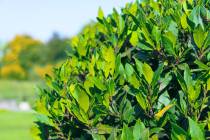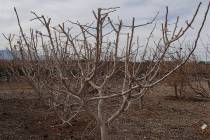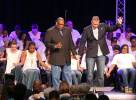With care you can keep normal-sized trees small
There will be a demonstration on how to topwork an older fruit tree today at noon at the University of Nevada Cooperative Extension Master Gardener Orchard in North Las Vegas. We will be topworking, or grafting, a 14-year-old Mutsu apple tree with Sundowner fruit wood. If you can attend, be at the orchard no later than 11:30 a.m.
The orchard is located at 4600 Horse Drive. For more information or directions, call the master gardener help line at 257-5555.
Q: I was wondering if you have some guides to pruning a dwarf nectarine tree?
A: When you are talking about dwarf nectarine tree I am assuming you are talking about what we call a miniature or genetic dwarf fruit tree. There are some fruit trees being marketed as dwarf that are on rootstocks that impart a small amount of dwarfing, but these are pruned normally.
However, genetic dwarves or miniature trees are pruned differently because they grow differently than standard trees. One example of a miniature nectarine is a variety called Garden Delight. As true of genetic dwarf nectarine, it grows very slowly and the branches terminate in multiple short, small stems. That is normal.
This combination of reduced growth rate and dividing the growth into many different growing points helps slow down the tree. The fruit is usually acceptable but I have found it to be highly variable in quality .
Normal-sized fruit trees have the potential to give you better quality fruit more consistently, year to year. Plus, with a little work you can keep normal-sized trees small .
That being said, when pruning miniatures start at the bottom of the tree and remove any limbs that will allow fruit to touch the ground. Bend the lower branches like they have a full load of fruit on them. If the branch touches the ground, get rid of the branch where it is attached to the trunk or a major limb. Do not leave a stub.
Next, go through and remove branches that are crossing or touching each other. You want to create spaces around major fruit-producing branches that can support large fruit without damaging them. This opens the canopy for better light penetration and air movement.
You should not have branches any closer than about a foot from each other. Remove branches that are too close together from their point of origin at the trunk or major limb. Once you have gone all the way around the tree removing branches that are too close together, then concentrate on the ends of the branches.
The ends will have four or five small stems that look like fingers originating from the older stem. Remove all but one of these stems so that only one "finger" remains. This should be the healthiest and most vigorous.
Following this guideline will reduce the amount of fruit thinning you will have to do in about another four to six weeks. You should still remove fruits that are too close together; do this when the fruit is about the size of a quarter and space the fruit 6 inches apart.
Q: I have a peach tree and the buds are swelling. When should I apply fertilizer, before or after bloom? Or should I follow the time frame of mid-March and mid-May? Should I use 10-10-10 on a mature tree or some other mix. I live in Sun City Anthem and the soil sucks.
A: Nearly all the soil here sucks. Some are filled with rocks and backfill, some with caliche, some don't drain, and some won't hold any water.
Now is a good time to fertilize . You should apply fertilizers to the soil just before or during flowering and fruiting. Fertilizers applied to the leaves, foliar types, should never be applied during flowering. It is best if the fertilizer is high in both nitrogen and phosphorus, at least. A 10-10-10 is fine. Any fertilizer that is blended to support both growth and flowering is best.
Stay away from lawn fertilizers. They are too high in nitrogen since they are focused on leaf growth and not flowering or fruiting. Rose fertilizers can be used, as can fertilizers for azaleas, citrus and even those for vegetables. Stay away from fertilizers for leafy green vegetables; they are high in nitrogen just like lawn fertilizers.
The fertilizer can be in the form of stakes or granular. You can use liquid fertilizers and spray them on the leaves. Foliar applications must be done multiple times during the spring and early summer whereas fertilizers applied to the soil can be done just once. You can't get enough fertilizer in the tree with a single application so you have to wait a few weeks and repeat it three or four times. Since fertilizers are salts, they can damage plants if they are placed too close to the trunks in the amount needed for a single application.
Apply the fertilizer near your source of water for the tree and let the water dissolve it and feed the roots. Slow-release fertilizers are more expensive but give you a longer feeding time and don't dump the fertilizer salts all at once.
Fertilizer stakes are usually slow release and a bit more expensive, but I like them, especially if you only have one or two trees to fertilize. They are not as messy and provide the right balance of fertilizer for fruit trees -- if you buy the ones for fruit trees .
You should also apply iron to apples, pears, peaches, plums, nectarines, apricots and most fruit trees. The iron should be an iron chelate called EDDHA in the ingredients .
Bob Morris is an associate professor with the University of Nevada Cooperative Extension. Direct gardening questions to the master gardener hot line at 257-5555 or contact Morris by e-mail at morrisr@unce.unr.edu.























